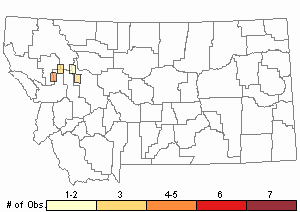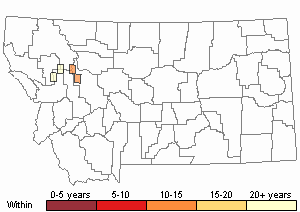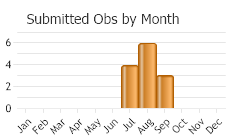View in other NatureServe Network Field Guides
NatureServe
Montana
Utah
Wyoming
Idaho
Wisconsin
British Columbia
South Carolina
Yukon
California
New York
Alpine Mountainsnail - Oreohelix alpina
Other Names:
Pyramidula strigosa alpina, Pyramidula strigosa montana
General Description
The shell is small, to 12 mm diameter but usually less than 10 mm (new-born young about 2 mm diameter), to 7 mm in height but usually less than 5 mm; heliciform with up to 4 1/2 whorls, depressed somewhat in profile with a low spire, umbilicus narrow and deep, aperture oval to nearly circular, periphery rounded or slightly carinate. Shell opaque and chalky, color is brownish-gray (dead shells to pearly white), with a series of reddish-brown spiral bands, two or more on the upper surface, a prominent band near the periphery on the lower surface, and one or more paler bands below that; bands may be evident on penultimate whorl, or may be very pale or absent entirely, probably from abrasion and exposure to sunlight. Smaller shells may have a brownish cuticle that is lost in larger individuals. Head, neck, and tentacles dark brown, darker than the shell (Hendricks 2012; Burke 2013). Internal anatomy described by Fairbanks (2002).
Phenology
Active in wet and cool weather; otherwise not described.
Diagnostic Characteristics
In the field best identified based upon a combination of size, location, and habitat. A combination of shell shape (flattened heliciform or flattened conic), small size, opaque shell color (especially chalky white when dead) with a few bands, absence of reflected lip, and absence of teeth in the aperture distinguishes this from other Montana land snails (Hendricks 2003). Most other species of Oreohelix in Montana are larger and less flattened; Oreohelix alpina appears to be the only member of the genus within its restricted range and alpine habitat, although recent field work on the Scapegoat Plateau in 2007 found Oreohelix elrodi (or a closely related undescribed form) in close proximity (< 50 m) to Oreohelix alpina but with no areas of sympatry or range overlap on the plateau (Hendricks et al. 2008; Hendricks 2012).
Species Range
Montana Range
Range Descriptions

 Native
Native
Range Comments
Montana endemic: Original description is based on specimens collected in 1900 above tree line on the southwest ridge of “Sin-yale-a-min [Sinyaleamin] Peak” known today as East St. Marys Peak near the southern end of the Mission Mountains, Lake County. In Montana, 11 records from six sites in four counties west of, or near, the Continental Divide: Lake (5), Lewis and Clark (2), Missoula (3), Powell (1). Elevation range is 2195 to 2957 m (7200 to 9700 ft). Populations in the Mission Mountains are probably completely isolated from those in the Bob Marshall/Scapegoat Wilderness complex. Sometimes locally abundant; as many as 160 (live and shells) were observed at one site in Lewis and Clark County in late July (Hendricks 1998, 2012; Hendricks et al. 2008; Burke 2013).
Observations in Montana Natural Heritage Program Database
Number of Observations: 13
(Click on the following maps and charts to see full sized version)
Map Help and Descriptions
Relative Density

Recency



 (Observations spanning multiple months or years are excluded from time charts)
(Observations spanning multiple months or years are excluded from time charts)
Migration
Non-migratory.
Habitat
Limestone talus at and above tree line. Tree canopy absent or minimal; canopy species where present include scattered whitebark pine, Engelmann spruce, and subalpine fir. Ground cover also minimal, but includes scattered dwarf willow, snow cinquefoil, alpine sorrel, mountain avens, stonecrop and moss campion. Live animals occur mostly under rocks and in duff or soil accumulations under rocks, sun-bleached shells may be found on the surface (Hendricks 1998, 2012; Hendricks et al. 2008).
Food Habits
Not described.
Reproductive Characteristics
Hermaphroditic (Fairbanks 2002), otherwise not described.
Threats or Limiting Factors
Occupied habitat (alpine and high-elevation limestone talus) is not threatened by current land use practices. Probably the greatest threat to species persistence is climate change (Hendricks 2003).
References
- Literature Cited AboveLegend:
 View Online Publication
View Online Publication Burke, T. E. 2013. Land snails and slugs of the Pacific Northwest. Corvallis, OR: Oregon State University Press. 344 p.
Burke, T. E. 2013. Land snails and slugs of the Pacific Northwest. Corvallis, OR: Oregon State University Press. 344 p. Fairbanks, H.L. 2002. The reproductive anatomy, taxonomic status, and range of Oreohelix alpina (Elrod, 1901) (Gastropoda: Pulmonata: Oreohelicidae). The Nautilus 116:62-65.
Fairbanks, H.L. 2002. The reproductive anatomy, taxonomic status, and range of Oreohelix alpina (Elrod, 1901) (Gastropoda: Pulmonata: Oreohelicidae). The Nautilus 116:62-65. Hendricks, P. 1998. Rediscovery of Discus brunsoni Berry, 1955 and Oreohelix alpina (Elrod 1901) in the Mission Mountains, Montana, with comments on Oreohelix elrodi (Pilsbry 1900). The Nautilus 112(2): 58-62.
Hendricks, P. 1998. Rediscovery of Discus brunsoni Berry, 1955 and Oreohelix alpina (Elrod 1901) in the Mission Mountains, Montana, with comments on Oreohelix elrodi (Pilsbry 1900). The Nautilus 112(2): 58-62. Hendricks, P. 2003. Status and conservation management of terrestrial mollusks of special concern in Montana. Unpublished report prepared for the U.S. Forest Service. Montana Natural Heritage Program, Helena, Montana. 67 pp. + appendices.
Hendricks, P. 2003. Status and conservation management of terrestrial mollusks of special concern in Montana. Unpublished report prepared for the U.S. Forest Service. Montana Natural Heritage Program, Helena, Montana. 67 pp. + appendices. Hendricks, P. 2012. A Guide to the Land Snails and Slugs of Montana. A report to the U.S. Forest Service - Region 1. Montana Natural Heritage Program, Helena, MT. vii + 187 pp. plus appendices.
Hendricks, P. 2012. A Guide to the Land Snails and Slugs of Montana. A report to the U.S. Forest Service - Region 1. Montana Natural Heritage Program, Helena, MT. vii + 187 pp. plus appendices. Hendricks, P., B.A. Maxell, S. Lenard, and C. Currier. 2008. Surveys and predicted distribution models for land mollusks on USFS Northern Region Lands: 2007. Report to the USDA Forest Service, Northern Region. Helena, MT: Montana Natural Heritage Program. 12 pp. + appendices.
Hendricks, P., B.A. Maxell, S. Lenard, and C. Currier. 2008. Surveys and predicted distribution models for land mollusks on USFS Northern Region Lands: 2007. Report to the USDA Forest Service, Northern Region. Helena, MT: Montana Natural Heritage Program. 12 pp. + appendices.
- Additional ReferencesLegend:
 View Online Publication
View Online Publication
Do you know of a citation we're missing? Elrod, M.J. 1901b. Montana shells. Rocky Mountain Magazine (May) 2(3):691-697.
Elrod, M.J. 1901b. Montana shells. Rocky Mountain Magazine (May) 2(3):691-697. Elrod, M.J. 1902. A biological reconnoissance in the vicinity of Flathead Lake. Bulletin of the University of Montana Number, Biological Series 10(3):89-182.
Elrod, M.J. 1902. A biological reconnoissance in the vicinity of Flathead Lake. Bulletin of the University of Montana Number, Biological Series 10(3):89-182. Elrod, M.J. 1903b. Montana shells - Pyramidula strigosa [Oreohelix alpina]. The Nautilus 17:1-6.
Elrod, M.J. 1903b. Montana shells - Pyramidula strigosa [Oreohelix alpina]. The Nautilus 17:1-6. Frest, T.J. and E.J. Johannes. 1995. Interior Columbia Basin mollusk species of special concern. Final report to the Interior Columbia Basin Ecosystem Management Project, Walla Walla, WA. Contract #43-0E00-4-9112. 274 pp. plus appendices.
Frest, T.J. and E.J. Johannes. 1995. Interior Columbia Basin mollusk species of special concern. Final report to the Interior Columbia Basin Ecosystem Management Project, Walla Walla, WA. Contract #43-0E00-4-9112. 274 pp. plus appendices. Pilsbry, H.A. 1939. Land Mollusca of North America (North of Mexico), Volume 1, Part 1. Monograph of the Academy of Natural Sciences of Philadelphia Monograph Number 3 (1): 1-573.
Pilsbry, H.A. 1939. Land Mollusca of North America (North of Mexico), Volume 1, Part 1. Monograph of the Academy of Natural Sciences of Philadelphia Monograph Number 3 (1): 1-573. Schaack, C.G. and P.F. Stickney. 1981. Type locality and distribution of Synthyris canbyi (Scrophulariaceae). Proceedings of the Montana Academy of Sciences 40:41- 43.
Schaack, C.G. and P.F. Stickney. 1981. Type locality and distribution of Synthyris canbyi (Scrophulariaceae). Proceedings of the Montana Academy of Sciences 40:41- 43.
- Web Search Engines for Articles on "Alpine Mountainsnail"
- Additional Sources of Information Related to "Snails / Slugs"





